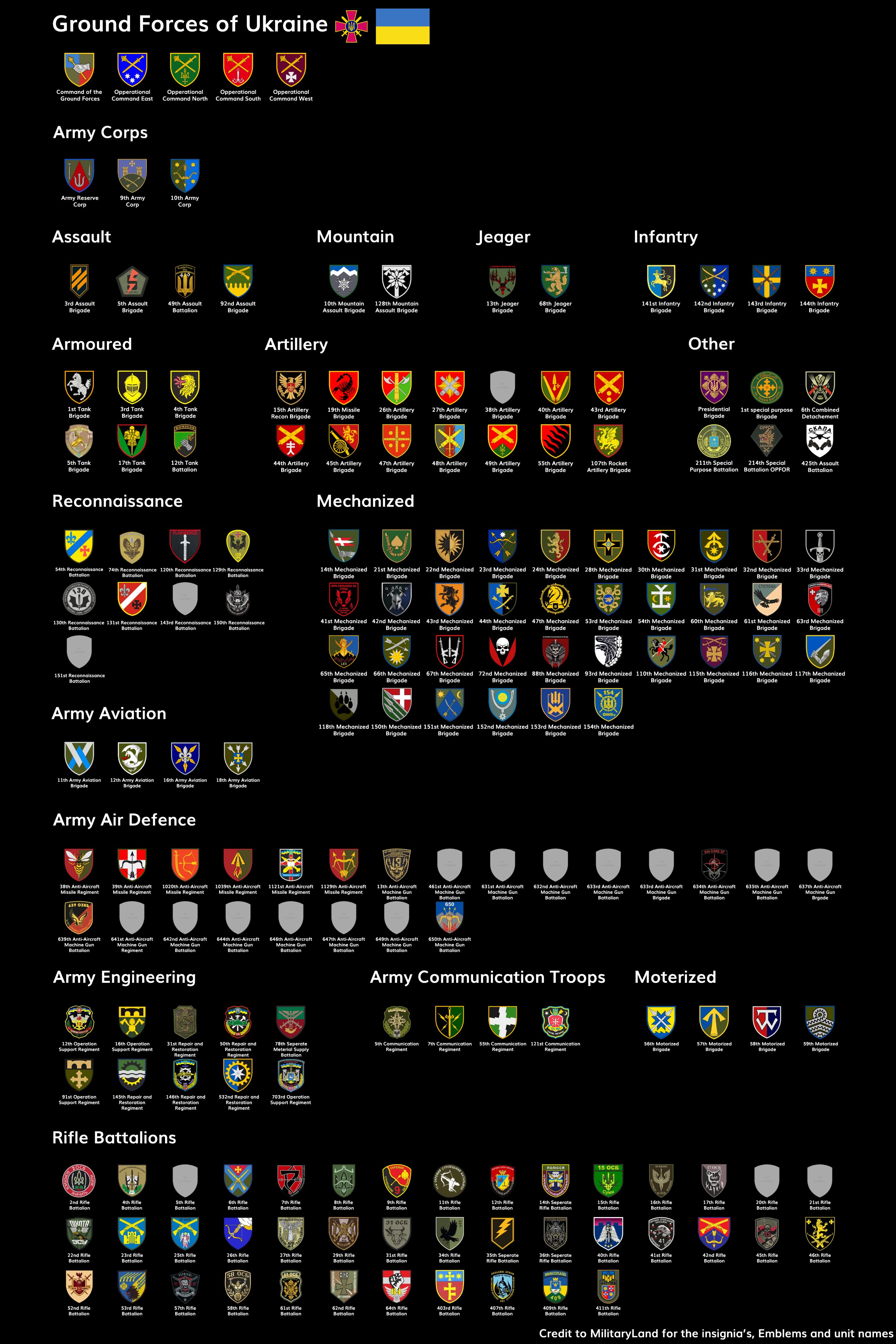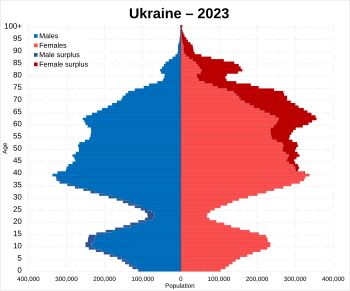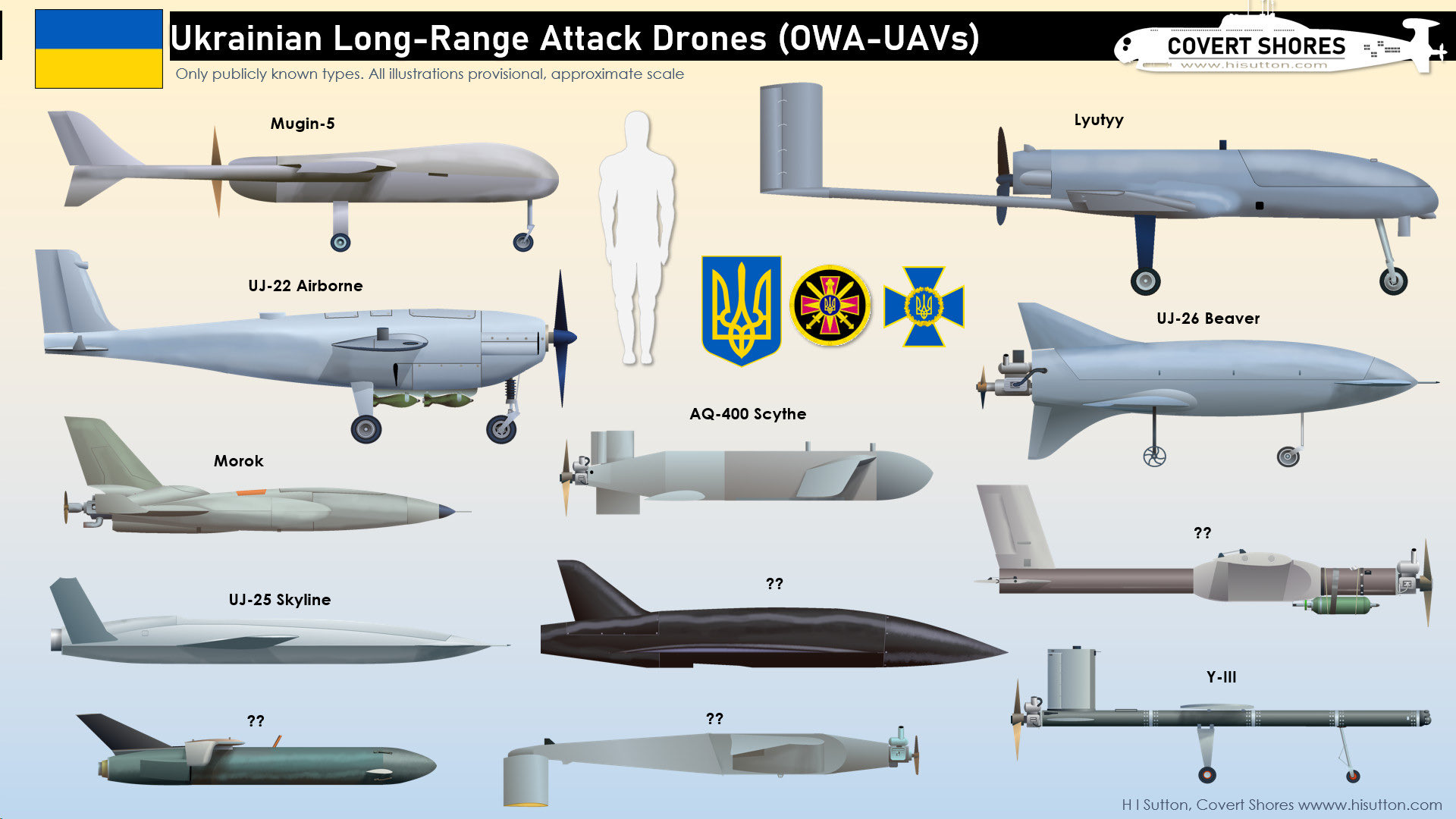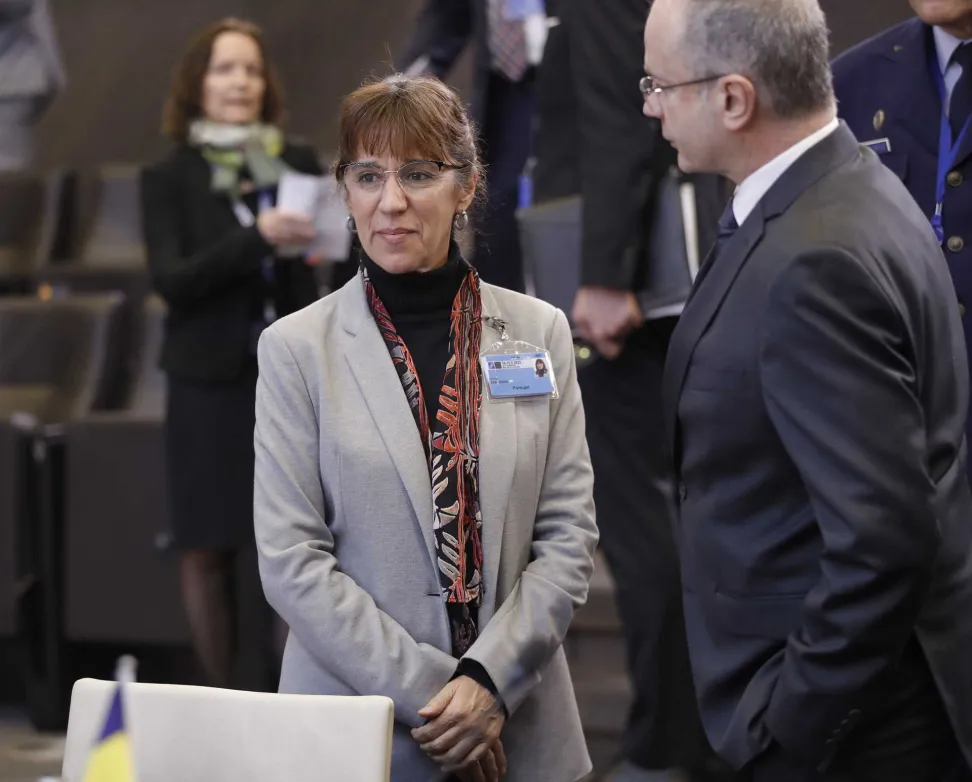Re: UCRÂNIA
Enviado: Qua Fev 14, 2024 6:57 am
Na verdade, 1.500 foi o número que se chegou a um possível agrupamento no centro de treinamento no momento que foi atacado, vale lembrar que algumas unidades da 110ª Bda que estavam em Avdiivka foram rotacionados pela primeira vez após dois anos, não tenho a menor dúvida que alguns ali estavam, pois é um lugar de rotação e concentração, além da própria 3ª Bda Azov que detém muito mais de 2k efetivos e tem muito mais autonomia do que as demais brigadas e tem voz em quais batalhas travar e principalmente como fazê-lo. Surgiu já algumas imagens de algumas unidades da 3ª Bda na coqueira.FOXTROT escreveu: Ter Fev 13, 2024 12:36 pm Os russos acertaram uma grande concentração de tropas ucranianas que estavam se reunindo na cidade de Selidovo a 40km de Avdeevka, dizem que o alvo foi a 3º Brigada de Assalto "Azov", essa briga estava encarregada de "libertar" Avdeevka. Relatos com número indeterminados de mortos (foram atingidos por Iskander OTRk, Smerch MLRS) de algumas centenas podendo chegar a 1500 mortos, a cidade está cercada pela AFU com Ambulâncias e caminhões frigoríficos.
Saudações

Russian Military Objectives and Capacity in Ukraine Through 2024
Russian forces are likely to peak in late 2024, with increasing material challenges over the course of 2025.
The process by which Russia aims to bring about this outcome is in three stages. The first requires the continuation of pressure along the length of the Ukrainian front to drain the Armed Forces of Ukraine's (AFU) munitions and reserves of personnel. Parallel to this effort, the Russian Special Services are tasked with breaking the resolve of Ukraine's international partners to continue to provide military aid. Once military aid has been significantly limited such that Ukrainian munition stocks become depleted, Russia intends to initiate further offensive operations to make significant – if slow – gains on the battlefield. These gains are then intended to be used as leverage against Kyiv to force capitulation on Russian terms. The planning horizon for the implementation of these objectives, which is providing the baseline for Russian force generation and industrial outputs, is that victory should be achieved by 2026.
Russian Military Capacity
The Russian military began 2023 with a highly disorganised force in Ukraine comprising approximately 360,000 troops. By the beginning of the Ukrainian offensive in June 2023, this had risen to 410,000 troops and was becoming more organised. Over the summer of 2023, Russia established training regiments along the border and in the occupied territories and, following the mutiny of Wagner forces, endeavoured to standardise its units, breaking down the previous trend towards private armies. By the beginning of 2024, the Russian Operational Group of Forces in the occupied territories comprised 470,000 troops.
Russian forces have reverted above battalion level to the traditional Soviet order of battle of regiments, divisions and combined arms armies, but have been significantly altered below the level of the regiment. Battalions are organised as line and storm battalions, and tend to operate in company groups which fight in small, dispersed detachments. This reflects not only adaptation to battlefield conditions, but also the shortage of trained officers able to coordinate larger formations, with a significant proportion of Russian junior officers currently being promoted from the ranks and receiving condensed officer training, sometimes as short as two months long.
The Russian Group of Forces continues to take significant casualties, but is nevertheless growing in size. Operating at greater scale allows the Russian military to take measures that guarantee the integrity of the front line. Units can generally be rotated out of the line once they have taken up to 30% casualties – the point at which they are judged to be ineffective – and are then regenerated. While no large-scale offensive is currently taking place, Russian units are tasked with conducting smaller tactical attacks that at minimum inflict steady losses on Ukraine and allow Russian forces to seize and hold positions. In this way, the Russians are maintaining a consistent pressure on a number of points. Although the Russian military’s aspiration to increase in size to 1.5 million personnel has not been realised, recruiters are currently achieving almost 85% of their assigned targets for contracting troops to fight in Ukraine. The Kremlin therefore believes that it can sustain the current rate of attrition through 2025.
No caso russo, as unidades são retiradas após uma perda de 50% da sua força de combate, esse é o ponto que os russos consideram uma unidade ineficaz e sem capacidade de combate, retirando-a da frente.
In terms of combat equipment, the Russian Group of Forces holds approximately:
4,780 barrel artillery pieces, of which 20% are self-propelled;
1,130 MLRS;
2,060 tanks; and
7,080 other armoured fighting vehicles, primarily consisting of MT-LBs, BMPs and BTRs.
These continue to be supported by 290 helicopters, of which
110 are attack helicopters, and
310 fast jets.
These equipment sets are limited in how they can be employed by ammunition shortages, especially for key natures like 220 mm multiple launch rocket systems (MLRS) and fluctuating availability of 152mm ammunition. Some sets, like fast air, are constrained by the availability of pilots with sufficient experience to carry out key missions. Russian air crew losses – including operators in the Il-20 Coot and A-50U Mainstay, shot down – amount to 159 personnel, which given the unevenness of flight hours in Russian squadrons amounts to a serious loss of capability. Nevertheless, the Russian Aerospace Forces (VKS) can continue to mount a significant sortie rate and deliver stand-off munitions. The overall assessment is that while Russian force quality is unlikely to increase so long as the AFU can maintain a significant level of attrition across the force, the Russians will be able to maintain a steady tempo of attacks throughout 2024.
Russian Industrial Capacity
In terms of Russian industry's capacity to support ongoing operations, Russia has significantly mobilised its defence industry, increasing shifts and expanding production lines at existing facilities as well as bringing previously mothballed plants back online. This has led to significant increases in production output. For example, Russia is delivering approximately 1,500 tanks to its forces per year along with approximately 3,000 armoured fighting vehicles of various types. Russian missile production has similarly increased. At the beginning of 2023, for instance, Russian production of Iskandr 9M723 ballistic missiles was six per month, with available missile stocks of 50 munitions. By the beginning of 2024, not only had Russia used a significant number of these missiles each month since the summer of 2023, but it had increased its stockpile to nearly 200 Iskandr 9M723 ballistic and 9M727 cruise missiles. A similar picture can be observed across other core missile types like the Kh-101.
Despite these achievements, Russia faces significant limitations in the longevity and reliability of its industrial output. Of the tanks and other armoured fighting vehicles, for example, approximately 80% are not new production but are instead refurbished and modernised from Russian war stocks. The number of systems held in storage means that while Russia can maintain a consistent output through 2024, it will begin to find that vehicles require deeper refurbishment through 2025, and by 2026 it will have exhausted most of the available stocks. As the number of refurbished vehicles goes down, industrial capacity can go into making new platforms, but this will necessarily mean a significant decrease in vehicles delivered to the military.
Another vulnerability for Russia's complex weapons like missiles is the extensive dependence on Western-sourced components. Although Russia has maintained a steady supply of the necessary components owing to the incoherent and lackadaisical approach to sanctions adopted by Western states, a more coherent approach to countering the Russian defence industry could disrupt supply lines. Even with the existing flawed approach, the cost of components has risen by 30% for the Russian defence sector, and it has only managed to stabilise supplies rather than expand them, despite extra investment in this line of effort.
Perhaps the most serious limitation for Russia, however, is ammunition manufacture. In order to achieve its aspiration to make significant territorial gains in 2025, the Russian Ministry of Defence (MoD) has assessed an industrial requirement to manufacture or source approximately 4 million 152mm and 1.6 million 122mm artillery shells in 2024. Russian industry has reported to the MoD that it expects to increase 152mm production from around 1 million rounds in 2023 to 1.3 million rounds over the course of 2024, and to only produce 800,000 122mm rounds over the same period. Moreover, the Russian MoD does not believe it can significantly raise production in subsequent years, unless new factories are set up and raw material extraction is invested in with a lead time beyond five years.
This means that to properly resource the armed forces, Russia must – in the short term – further draw down its remaining 3 million rounds of stored ammunition, though much of this is in poor condition. To further compensate for shortages, Russia has signed supply and production contracts with Belarus, Iran, North Korea and Syria, with the latter only able to provide forged shell casings rather than complete shells. Although the injection of around 2 million 122mm rounds from North Korea will help Russia in 2024, it will not compensate for a significant shortfall in available 152mm munitions in 2025. Russian overall artillery production is likely to plateau at 3 million rounds per year of all natures – including MLRS, which is not considered above.
Conclusions
The Russian theory of victory is plausible if Ukraine's international partners fail to properly resource the AFU. However, if Ukraine's partners continue to provide sufficient ammunition and training support to the AFU to enable the blunting of Russian attacks in 2024, then Russia is unlikely to achieve significant gains in 2025. If Russia lacks the prospect of gains in 2025, given its inability to improve force quality for offensive operations, then it follows that it will struggle to force Kyiv to capitulate by 2026. Beyond 2026, attrition of systems will begin to materially degrade Russian combat power, while Russian industry could be disrupted sufficiently by that point, making Russia's prospects decline over time. The latter would require Ukraine's partners to demonstrate a semblance of competence in their measures aimed at countering Russian defence mobilisation, which remains eminently possible in spite of their performance to date.
Adopting an approach that aims to ensure Ukraine's resistance through 2025 not only undermines the Kremlin's theory of victory but also provides sufficient time to establish a rational mobilisation and training process for the AFU such that it can begin to qualitatively outmatch Russian forces, even if the latter continue to increase in overall size. This is critical to building opportunities to continue to threaten Russia's position and thereby force Russia not just to seek negotiations, but to actually negotiate an end to the war on terms favourable to Ukraine. Now is not the time to comply with the Kremlin's understanding of the war's trajectory.
Naiev(agora ex-comandante das forças conjuntas) está fora, foi substituído por Yuri Sodol (atual comandante dos fuzileiros navais). Além disso, Oleksandr Pavliuk é agora o comandante das Forças Terrestres(substituindo Syrsky).Recently dismissed Joint Forces Commander says he found out about his dismissal from news headlines
Serhii Naiev, Commander of the Joint Forces of the Armed Forces of Ukraine, has indicated that he learned about the presidential decree on his dismissal from the mass media on 11 February.
https://euromaidanpress.com/2024/02/10/ ... reshuffle/A mudança de comandante foi implementada em um momento ruim e ainda pode sair pela culatra na Ucrânia
O comandante das Forças Armadas da Ucrânia foi alterado de Valery Zaluzhny para Oleksandr Syrskyi. O caso fala de uma profunda contradição entre a estratégia declarada da administração ucraniana e a difícil situação na frente, escreve o verificador de factos do HS, John Helin.
Entra Syrskyi, sai Zaluzhnyi. O que as nossas fontes militares esperam da remodelação militar da Ucrânia
O novo comandante-em-chefe da Ucrânia enfrenta uma situação crítica na linha da frente, problemas institucionais e questões de confiança



Imagens de um Mi-24 russo perseguindo um drone ucraniano na região de Leningrado.
Anteriormente, helicópteros já eram usados para caçar drones ucranianos. Assim, em agosto de 2023, um Mi-28N abateu um drone inimigo na região de Oryol ( vídeo em primeira pessoa ). Outro Mi-28N afastou o drone das Forças Armadas Ucranianas da Crimeia.
Além disso, as Forças Aeroespaciais criaram unidades especiais de helicópteros projetadas para caçar UAVs.
Imagens do treinamento de artilheiros da Guarda Russa por instrutores Wagner em um dos campos de treinamento.
O treinamento é conduzido em um obus D-30 de 122 mm com freio de boca com fenda.
https://www.rand.org/pubs/research_repo ... 510-2.htmlKiev pode perder ainda mais: a corporação analítica Rand apelou às autoridades dos EUA para acabarem rapidamente com a guerra na Ucrânia
Caso contrário, o país poderá perder ainda mais território, e o risco de uma guerra direta entre a Rússia e a OTAN aumentará, segundo relatório da Rand, que também realiza análises para o Pentágono.
Embora tenha se tornado difícil para os políticos dos EUA irem além das soluções militares, eles deveriam abandonar o conceito de uma guerra “longa e brutal” entre a Ucrânia e a Federação Russa. “Terá consequências adversas a longo prazo e provavelmente irreversíveis para os Estados Unidos”.
Estamos a falar das consequências económicas para o Ocidente e para a Ucrânia, que serão negativas, independentemente da estratégia pós-guerra que os Estados Unidos escolham.
Mas os esforços dos EUA para acabar com a guerra o mais rapidamente possível “proporcionarão à Ucrânia melhores oportunidades para dissuadir uma futura invasão russa”.
“Os Estados Unidos podem promover um cessar-fogo mais rigoroso, o que poderia reduzir o risco de escalada e de nova guerra. Washington também poderia encorajar Kiev a adoptar uma postura militar defensiva, em vez de se concentrar na retomada do território controlado pela Rússia. Isto poderá limitar a capacidade de Kiev de libertar territórios ocupados, mas tornará mais difícil para a Rússia tomar novos territórios”, afirma o relatório.
Além disso, uma guerra de desgaste prolongada aumenta o risco de a China começar a fornecer armas e munições à Rússia, o que causará uma deterioração acentuada nas relações entre Pequim e os Estados Unidos e, portanto, aumentará os riscos de uma guerra em Taiwan.
Numa guerra prolongada, a Ucrânia provavelmente perderá ainda mais territórios do que agora.
Rand também alerta os EUA contra uma estratégia “dura” do pós-guerra. “O conflito entre os Estados Unidos e a Rússia poderá resultar da resposta assertiva de Moscovo às políticas linha-dura [do Ocidente].”
Avaliações inimigas interessantes sobre a intensidade do uso de bombas com módulos UMPC. O recorde é de 120 por dia (de acordo com o inimigo) e o nível de produção diária (novamente, de acordo com estimativas do inimigo público) é de 50 ou mais por dia . Esta estimativa pode diferir da realidade, tanto no sentido da superestimação quanto no sentido da subestimação. Mas esses ainda são alguns números nos quais você pode confiar para comparações.
E embora o UMPC não seja o exemplo mais preciso de VTO disponível, ainda é um tipo de arma de alta precisão.
E aqui é interessante comparar a intensidade do uso de “bombas inteligentes” com outros conflitos exército-contra-exército.
Em 1991, 9.342 bombas guiadas foram usadas contra o Iraque em 43 dias. Isto é uma média de 217 bombas por dia.
Em 2003, na mesma área, foram utilizadas 16.771 “bombas aéreas inteligentes” em 31 dias – uma média de 521 por dia.
Em geral, os números publicados parecem, por um lado, insignificantes no contexto do “rolo de bombas inteligentes” dos EUA, mesmo há 20-30 anos.
Mas, por outro lado, a lacuna actualmente não parece tão intransponível, mesmo de acordo com estes dados. E isto dá razão para um optimismo cauteloso de que, à medida que os indicadores aumentam, os efeitos visíveis deste crescimento no campo de batalha começarão a mudar.
https://www.iiss.org/online-analysis/mi ... ine-mount/O sistema energético de Dnepropetrovsk e toda a sua infraestrutura “está por um fio”, disse o prefeito da cidade, Boris Filatov, após a greve noturna.
O responsável ucraniano apelou também às autoridades superiores da Ucrânia para que parem de prender e enviar para o exército funcionários das empresas de serviços públicos da cidade, uma vez que agora não tem gente suficiente para eliminar as consequências das greves.
Recordemos que esta noite “Gerânios” atingiram a infra-estrutura energética de Dnepropetrovsk, o que causou cortes de energia e o encerramento de escolas e hospitais.

O pior? Pior que quando a Rússia ocupava muito mais território e em que o apoio internacional não era tão vincado?!FOXTROT escreveu: Qui Fev 15, 2024 9:21 am De se ressaltar o excelente trabalho da Força Aérea Russa em Avdeevka, que começa a cair em um ritmo acelerado. A pressão em Chasiv Yar é grande também, Ucrânia parece estar no pior momento da guerra.
Saudações



cabeça de martelo escreveu: Qui Fev 15, 2024 12:42 pm Portugal avança com um milhão de euros para compra de munições para a Ucrânia
A ministra da Defesa apontou que a necessidade "mais urgente" dos ucranianos são munições de 155 milímetros.
Olivier Hoslet/EPA (arquivo)
Lusa
A ministra da Defesa Nacional, Helena Carreiras, anunciou esta quinta-feira que Portugal vai contribuir com um milhão de euros para a compra conjunta de munições de grande calibre para a Ucrânia.
"No âmbito do acordo que assinámos com a Agência Europeia de Defesa, no ano passado, vamos poder participar com um milhão de euros para a aquisição de munições para a Ucrânia neste esforço conjunto", anunciou Helena Carreiras, no final de uma reunião ministerial no quartel-general da Organização do Tratado do Atlântico Norte (NATO), em Bruxelas.
A governante acrescentou que as munições de grande calibre, especificamente as de 155 milímetros, são a necessidade "mais urgente que a Ucrânia tem".
O investimento português na aquisição conjunta de munições faz parte de um objetivo da União Europeia de conseguir um milhão de munições de artilharia até ao final do ano.
Helena Carreiras anunciou também que Portugal vai dar este ano formação, em território nacional, a militares da Força Aérea da Ucrânia, com uma duração de quatro a seis meses, nas áreas do controlo de tráfego aéreo e manutenção de caças F-16.
"Essa formação será para muito breve, está neste momento a ser ultimada na sua preparação", completou, acrescentando que Portugal se disponibilizou para receber militares ucranianos para participarem em exercícios da Força Aérea Portuguesa que estão planeados para este ano.
A União Europeia comprometeu-se no início do ano passado com a entrega de um milhão de munições de artilharia à Ucrânia, para tentar colmatar as necessidades no terreno.
Até ao final do ano pouco mais de um terço do objetivo tinha sido alcançado, o que levou a Comissão Europeia a reconhecer em janeiro deste ano que ia falhar a promessa feita.
Entretanto, a Comissão Europeia estabeleceu um novo objetivo de enviar até ao final de 2024 um milhão de munições de grande calibre, aproveitando os projéteis que já tinha adquirido no âmbito da promessa feita anteriormente ao Governo ucraniano.
https://www.tsf.pt/7704299334/portugal- ... um=twitter
Sabes, esta doação é para lá de ridícula e mostra o "interesse" Socialista na Defesa tanto de Portugal, como da Europa. Simplesmente ridículo!!!FOXTROT escreveu: Qui Fev 15, 2024 3:42 pm Que sorte a minha que não vou pagar a conta!


Caiu a Fortaleza Zenit em Avdeevka
Saudações